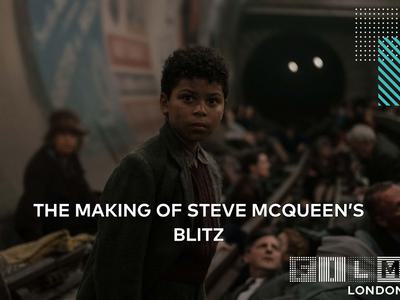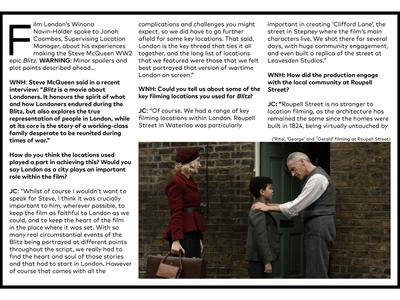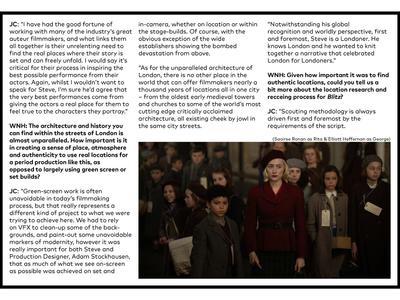News Story
Open an image gallery




Download PDF of interview here.
Plain text version:
Film London’s Winona Navin-Holder spoke to Jonah Coombes, Supervising Location Manager, about his experiences making the Steve McQueen WW2 epic Blitz. WARNING: Minor spoilers and plot points described ahead…
WNH: Steve McQueen said in a recent interview: “Blitz is a movie about Londoners. It honours the spirit of what and how Londoners endured during the Blitz, but also explores the true representation of people in London, while at its core is the story of a working-class family desperate to be reunited during times of war.”
How do you think the locations used played a part in achieving this? Would you say London as a city plays an important role within the film?
JC: “Whilst of course I wouldn’t want to speak for Steve, I think it was crucially important to him, wherever possible, to keep the film as faithful to London as we could, and to keep the heart of the film in the place where it was set. With so many real circumstantial events of the Blitz being portrayed at different points throughout the script, we really had to find the heart and soul of those stories and that had to start in London. However of course that comes with all the complications and challenges you might expect, so we did have to go further afield for some key locations. That said, London is the key thread that ties it all together, and the long list of locations that we featured were those that we felt best portrayed that version of wartime London on screen.”
WNH: Could you tell us about some of the key filming locations you used for Blitz?
JC: “Of course. We had a range of key filming locations within London. Roupell Street in Waterloo was particularly important in creating ‘Clifford Lane’, the street in Stepney where the film’s main characters live. We shot there for several days, with huge community engagement, and even built a replica of the street at Leavesden Studios.”
WNH: How did the production engage with the local community at Roupell Street?
JC: “Roupell Street is no stranger to location filming, as the architecture has remained the same since the homes were built in 1824, being virtually untouched by both property developers and the Blitz! Because of that, the street has a very strong Residents Association, which is useful as they are able to represent the tight-knit community that live there today. We devised a program of different social benefits, including reaching out to local schools and colleges offering work experience on set. Slight spoiler here for anyone who hasn’t seen the film yet… but we establish the community that the main characters, Rita (Saoirse Ronan), George (Elliott Heffernan) and Gerald (Paul Weller) live in early on in the film. Later we see that same community come under fire, with the streets they live in being blown up, which is what we used the replica for at the backlot of Leavesden. We were able to invite the residents to come and see the bombed-out sets, and what their street would have looked like had it been hit during the Blitz.”
“Other key locations included Wicklow Street in Kings Cross, which was used for a brief but very important war-torn beat in the film, where Rita emerges from a night in the shelter, walking through the streets after a night’s bombing campaign. Cornhill in the City was used for when George first lands in central London and is bewildered by all the hustle and bustle. Recreating wartime central London in full swing was a challenge and required getting countless stakeholders to all pledge their willingness and support. But it was also a great achievement in terms of all the shop dressing, and creating a whole length of period correct exteriors for the bus journey. Mildmay, which is an old working men’s club in Newington Green was another (Steve McQueen and Elliott Heffernan on set) fun one, Steve actually had to become a member of the club to help get us the access we needed! Amongst others, I would also say St Paul’s Cathedral was a key location, it’s only really a glimpse, but crucial for the surviving wartime beacon it has become.”
WNH: Steve McQueen is widely considered to be an auteur within contemporary cinema, does working with a director that has such a clear vision change your job at all as a Location Manager?
JC: “I have had the good fortune of working with many of the industry’s great auteur filmmakers, and what links them all together is their unrelenting need to find the real places where their story is set and can freely unfold. I would say it’s critical for their process in inspiring the best possible performance from their actors. Again, whilst I wouldn’t want to speak for Steve, I’m sure he’d agree that the very best performances come from giving the actors a real place for them to feel true to the characters they portray.”
WNH: The architecture and history you can find within the streets of London is almost unparalleled. How important is it in creating a sense of place, atmosphere and authenticity to use real locations for a period production like this, as opposed to largely using green screen or set builds?
JC: “Green-screen work is often unavoidable in today’s filmmaking process, but that really represents a different kind of project to what we were trying to achieve here. We had to rely on VFX to clean-up some of the backgrounds, and paint-out some unavoidable markers of modernity, however it was really important for both Steve and Production Designer, Adam Stockhausen, that as much of what we see on-screen as possible was achieved on set and in-camera, whether on location or within the stage-builds. Of course, with the obvious exception of the wide establishers showing the bombed devastation from above.
“As for the unparalleled architecture of London, there is no other place in the world that can offer filmmakers nearly a thousand years of locations all in one city – from the oldest early medieval towers and churches to some of the world’s most cutting edge critically acclaimed architecture, all existing cheek by jowl in the same city streets. Notwithstanding his global recognition and worldly perspective, first and foremost, Steve is a Londoner. He knows London and he wanted to knit together a narrative that celebrated London for Londoners.”
WNH: Given how important it was to find authentic locations, could you tell us a bit more about the location research and recceing process for Blitz?
JC: “Scouting methodology is always driven first and foremost by the requirements of the script. From there me and my team can begin pulling references from my library of film archives, whilst at the same time going out to various organisations and agencies and cataloguing prospective street exteriors. Surprisingly (and somewhat alarmingly), I’ve been doing this job for over 20 years now and I’ve covered all sorts of periods over the years, from medieval through to the 1980s, and post-apocalyptic London to near and distant futures, so I’ve got an extensive archive of material that I can refer to and use as a reference to get the right kind of feel, or the right kind of look or scale for any given exterior or interior space. It was then a process of putting things in front of Steve and Adam to get a temperature-check on how they were feeling about certain locations, which would then inform the on-going research.”
WNH: Were there any particular challenges that you faced on location or any moments that you’re particularly proud of?
JC: “In terms of achievement, Wicklow Street in Kings Cross. The ‘knife-edge’ to pull it all together on time was hugely stressful, but we managed it and it looks great, even if it’s only seen for a very brief moment! We closed the street, and filmed the sequence I mentioned earlier, where Rita emerges from the bomb shelter and walks through the freshly bombed destruction. There are people in their houses, injured and trying to clear up, and it really shows the way that people still tried to go about their daily routines in amongst all of the death and destruction of the bombing campaigns. The sequence is really just a beat of her walking down the street, and Wicklow Street worked so well for us because it’s cobbled and is pretty much surrounded by period-correct buildings and, crucially, it had empty plots where we could build the bombed-out structures: a Car Park, a bit of empty scrub-land owned by a family in Ilford, and the remnants of an empty hospital building. We needed to make use of all three plots, so that we could build the destruction in the empty spaces, so that once Rita walked down the street, it was a mixture of period buildings and bombed devastation, with special effects inserted all around it. We had all three plots lined up, and everything was looking good when at the 11th hour a stakeholder popped up with safety concerns about how close our build was to some train tracks. This meant we were at risk of losing access to one of the plots of land right before shooting began. I had already committed a significant amount of money to the other two plots, so it was a real nail biting moment trying to satisfy the health & safety requirements, in order to keep the shoot on track, and have the location ready in time for the scenes we had planned there. I would say it was the most stressful of all the sets of the film for me, and ironically when we finally got to shoot there, we shot for six hours and we were done. So to give you an idea, six months of blood, sweat and tears equated to six hours of shooting, which will probably equate to sixty seconds of screen time. Which I think is a good example of the huge departure between the reality of what we do and what the audience sees on screen. But it’s a really important little sequence, because it’s the moment where she sees the destruction of the night before.
“Steve, I think, very much wanted to portray the spirit London had, of saying “OK, the front of my house has just been blown off, but I’m still going to sweep the floor”. It’s in that commitment to just crack-on with daily life, and I’m sure that is something that won’t be lost on the audience. So whilst it was perhaps the most challenging to achieve, it was also the one that we felt the most proud of.
“The other one I think was really quite special, was the build that we did in Nevada Street in Greenwich, which became an absolutely brilliant station exterior, used to show all of the drama of the public trying to get into the stations to use them as air raid shelters – which for much of the Blitz was ‘unlawful’, another of the real stories that Steve wanted to tell. Nevada Street is basically a very sweet little period Street, with terrace houses, and period shops which has a gap halfway down which is used as gateway for the University of Greenwich. What we did was build the exterior of the tube station in the gap, between the period terrace houses and shops and it was so well done that people who lived in the area were walking down the street, double-taking at this new station that had suddenly popped up, asking if there had always been a tube station there, and they had just never realised - it was so well done it looked like it had been there forever!
“Davies Mews, on the border of Bond Street and Mayfair was also a huge achievement. We had to get the clearance to shoot there in the run-up to Christmas, recreating a bombed street scene in the heart of high-end central London. As I mentioned earlier, in relation to green screen versus real locations, Steve and Adam, both wanted to do the work in camera, to get things as close to reality as they possibly could. Ultimately, I think to motivate the performances of the actors, and to properly set the scene. So, in order to achieve this, and get rid of the glow that is created by artificial light, we had to turn off every light in the surrounding area, and I mean every light. From residential properties, to the backs of shops and hotels, to the Christmas lights lining the street. As you can imagine, it was a real tall order, but we managed to pull it off which was amazing.
“The other great thing about this location, was watching England play in the Euros with Stephen Graham and Kathy Burke in the pub – priceless! When they weren’t needed on camera or on set, we had set up a kind of green room space in the pub round the corner, where those that could, watched the football. It was brilliant, as they both have this very expressive, colourful language in their own very distinct accents - you’ve got Stephen Graham, with his thick Liverpudlian accent, and then you’ve got Kathy Burke, who is very clearly a Londoner, both screaming and shouting at the television. A rare treat.”
WNH: Would you be able to tell us what scene was filmed at Davies Mews?
JC: “Davies Mews was used for a bombed exterior shot of Café De Paris, where a night of revelry with live music and dancing was in full swing when it took a direct hit in the bombing campaign. Ken ‘Snakehips’ Johnson was a real jazz musician, and somewhat of a star at this time, and he was playing at the coveted Café De Paris that night. He was performing as bombs were going off all around them, and I think they believed that as the Café was underground, they would be safe from the destruction. So, as the bombs fell, he kept going, conducting the band to play louder and louder. Again, it was that attitude of Londoners at the time, adamant that they were going to carry on with the party and not let the war break their spirit. I won’t give too much away of how that scenes ends, but I think more than anything it’s just another strong true story that was brought to life. There are lots of true stories that run through the film, like that night at Café De Paris, the underground stations not being allowed to be used as Air Raid Shelters, the station being flooded with water, and all the sort of terrible things that happened during the Blitz that don’t really get told as anecdotal references from that time.”
WNH: Were there any key action sequences filmed on location?
JC: “We managed to pull off a very complex action sequence at Chatham Historic Dockyard, which was quite an achievement as they don’t ordinarily allow naked flame because of the very precious period listed interiors and exteriors. The scenes we shot there inform a very dramatic moment in the narrative, and it was great that we were able to capture the fire in camera, rather than it being all visual effects. We had a huge fire sequence, horses running around, and lots of actors in the scene, so it was the choreography of all those components whilst trying to get the fire to the scale that we had it, and convince Chatham that it could all be done very safely. It was definitely challenging, but a great feat to pull off.”
WNH: Overall, how would you describe your experience shooting Blitz?
JC: “I think overall the experience was hugely demanding, and therefore extremely rewarding. We had an absolutely brilliant location team that all pulled together to achieve the impossible, the unsung heroes lost in an end-roller of hundreds of crew members. We definitely couldn’t have done it without them, so I want to say a massive thank you to our whole department. From the trainees, to the most experienced members of crew, their contribution was critical to the success of what we achieved. It was definitely a very challenging project, working with a very emotive subject matter, which I think had a profound effect on all of us. I always used to talk about 28 Weeks Later as being one of the films that I was most proud of, in terms of what we achieved, and how we pulled it together to shoot post-apocalyptic London, which in the winter, at that time was really hard, but I think Blitz definitely eclipses that. Shooting 28 Weeks Later was over 15 years ago, so it was a very different world back then. We were closing Whitehall and Parliament Square, and running stunts around Central London. I think nowadays, with London as busy as it is, the legislation and restrictions are even more challenging. So, what we were able to achieve on Blitz, I think it was actually quite brilliant.
“I think location management is a part of production that doesn’t necessarily get the recognition it deserves, for our quite critical contribution to the filmmaking process. In giving a film a sense of place and creating real world settings. It’s a challenging job, and we take pride in our work, so it’s great to be able to share in more detail what goes into it. Also, just to reflect on what an amazing city London is to film in. The unparalleled architecture of London that we’ve already discussed, going back over nearly 1000 years, right up to cutting edge architecture of today, all in one place. From the medieval world to the near future, it’s all possible, because London has got so much to offer.”
Interview by Winona Navin-Holder
Blitz is in cinemas now, watch the trailer here